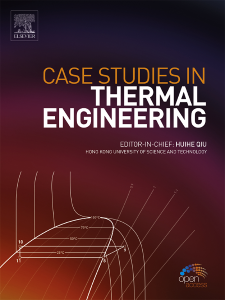Numerical analysis of rack-based data center cooling with rear door heat exchanger (RDHx): Interrelationship between thermal performance and energy efficiency
IF 6.4
2区 工程技术
Q1 THERMODYNAMICS
引用次数: 0
Abstract
This study presents a comprehensive numerical analysis of thermal performance and energy efficiency, IT operating environment, and thermal performance of the RDHx system, a rack-based cooling solution for high-density IT power using air-cooled equipment. A 150 kW IT module and RDHx cooling system were designed and evaluated, and CFD numerical analysis confirmed that RDHx maintains a stable IT environment within ASHRAE standards at a supply air temperature of 24 °C. Additionally, the chilled water supply temperature for the secondary CDU can be increased to 14 °C, and for the primary chiller to 12 °C. A central chilled water system for a 30 MW reference data center was designed and analyzed, showing increased efficiency with a 12 °C supply temperature and varying condenser water return temperatures in winter, resulting in an annual PUEcooling range of 1.25–1.33, with an average of 1.27. The annual energy consumption distribution for rack-based cooling is approximately 46 % from chillers, 21 % from fans, and 33 % from pumps. These results provide crucial insights into data center cooling and support the application of the RDHx system in high-density data centers, with future validation involving a field mock-up test of a 150 kW IT module.
采用后门热交换器 (RDHx) 的机架式数据中心冷却数值分析:热性能与能效之间的相互关系
本研究对 RDHx 系统的热性能和能效、IT 运行环境以及热性能进行了全面的数值分析,RDHx 系统是一种基于机架的冷却解决方案,适用于使用风冷设备的高密度 IT 电源。对 150 千瓦 IT 模块和 RDHx 冷却系统进行了设计和评估,CFD 数值分析证实,在供气温度为 24 °C 的条件下,RDHx 可保持稳定的 IT 环境,符合 ASHRAE 标准。此外,二级 CDU 的冷却水供应温度可提高到 14 °C,一级冷却水供应温度可提高到 12 °C。对一个 30 兆瓦参考数据中心的中央冷却水系统进行了设计和分析,结果表明,在供水温度为 12 °C、冬季冷凝器回水温度不同的情况下,效率有所提高,年 PUEcooling 范围为 1.25-1.33,平均为 1.27。机架式冷却的年能耗分布约为 46% 来自制冷机,21% 来自风扇,33% 来自水泵。这些结果为数据中心冷却提供了重要依据,支持 RDHx 系统在高密度数据中心的应用,未来还将对 150 千瓦 IT 模块进行现场模拟测试验证。
本文章由计算机程序翻译,如有差异,请以英文原文为准。
求助全文
约1分钟内获得全文
求助全文
来源期刊

Case Studies in Thermal Engineering
Chemical Engineering-Fluid Flow and Transfer Processes
CiteScore
8.60
自引率
11.80%
发文量
812
审稿时长
76 days
期刊介绍:
Case Studies in Thermal Engineering provides a forum for the rapid publication of short, structured Case Studies in Thermal Engineering and related Short Communications. It provides an essential compendium of case studies for researchers and practitioners in the field of thermal engineering and others who are interested in aspects of thermal engineering cases that could affect other engineering processes. The journal not only publishes new and novel case studies, but also provides a forum for the publication of high quality descriptions of classic thermal engineering problems. The scope of the journal includes case studies of thermal engineering problems in components, devices and systems using existing experimental and numerical techniques in the areas of mechanical, aerospace, chemical, medical, thermal management for electronics, heat exchangers, regeneration, solar thermal energy, thermal storage, building energy conservation, and power generation. Case studies of thermal problems in other areas will also be considered.
 求助内容:
求助内容: 应助结果提醒方式:
应助结果提醒方式:


